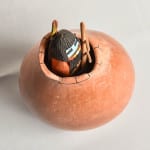This is a unique pairing of clay jar and wooden carving. Their combination is a demonstration of the creative talent of Randall Sahmie and a reminder of what we have lost too soon.
The jar is almost undecorated and is in the shape of an ovoid pressed slightly flat. The finish and form are smooth and invite a caress, like a water-worn stone. The lip has been cut away to form a high rim that steps down to a lower section. Three thin black lines form inverse “Y” elements along the lower rim. Two casually drawn lines are drawn below but parallel to the higher rim; several shorter lines run perpendicular. This minimal design suggests the masonry blocks that form traditional kivas.
Randall (1950 – 2008) was better known as a painter and katchina carver than a potter. For this pot he has taken a stick of wood and carved the head of Angakchina or “Long-Haired Katchina” on one end. Assembled separately by Randall was a two-step ladder that was originally glued to the stick. The stick was then glued inside the jar so that Angakchina appears to be climbing out of his kiva to dance in the village plaza. It’s a striking image, especially if you have ever seen katchinas emerge from their kiva a dawn.
Note that only other depiction of Angakchina in this collection is found on bowl 2015-05 by Lawrence Namoki, also a katchina carver as well as potter.











